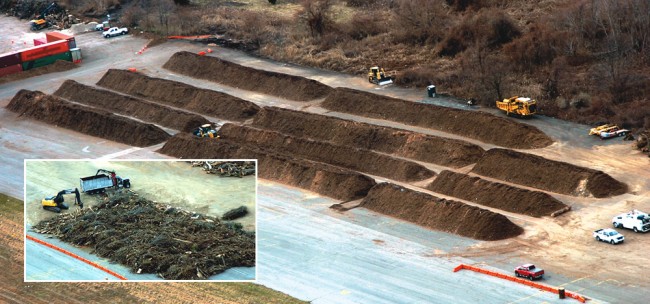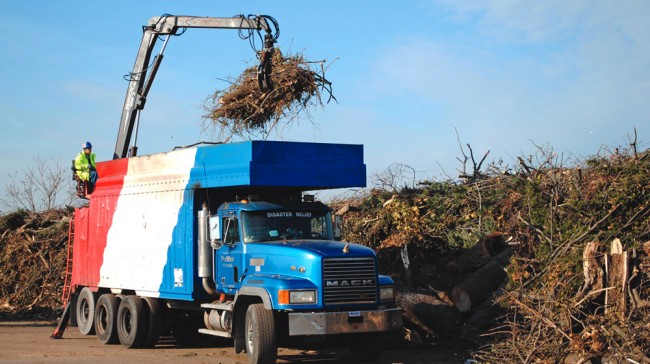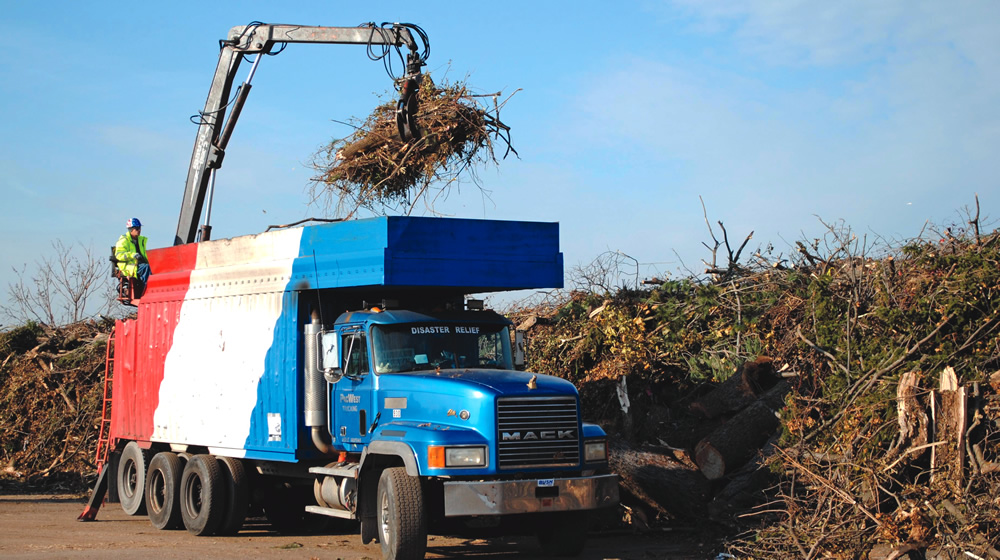As of mid-December, New York City had collected over 240,000 cubic yards of woody debris. Over 11,000 trees came down during the storm.
Diane Greer
BioCycle January 2013, Vol. 54, No. 1, p. 38

The U.S. Army Corps of Engineers is using the runways of Floyd Bennett Field in Brooklyn, New York to store (inset) and process vegetative debris from Hurricane Sandy.
New York City’s trees took a beating from Hurricane Sandy. The huge rows of wood chips and massive piles of tree trunks and limbs at Floyd Bennett Field in Brooklyn attest to the staggering amount of damage inflicted by the storm. So far, the City has collected over 240,000 cubic yards of woody debris, enough to fill a football field to a depth of 112 feet. “Prior to Superstorm Sandy the largest storm event was Tropical Storm Irene in 2011, which devastated approximately 3,400 trees,” says Jeremy Barrick, Deputy Chief of Forestry, Horticulture & Natural Resources at the New York City (NYC) Department of Parks & Recreation (the Parks Department). “Sandy took almost four times that many trees with over 11,000 down.”
In the aftermath of the storm the Federal Emergency Management Agency (FEMA) asked the Army Corps of Engineers (USACE) to manage the removal and disposal of storm debris in NYC. USACE is managing large storage areas for vegetative debris and working with government entities and private contractors to remove and properly handle the materials. The New York State Department of Environmental Conservation (DEC), the U.S. EPA and others are assisting USACE in this undertaking.
Ongoing Collection
The ongoing collection of wood debris from the storm is a team effort. USACE is working with the Parks Department and the NYC Department of Sanitation (Sanitation Department) to gather vegetative debris and keep it separate from other waste streams. “There are a variety of folks on the ground collecting the materials,” explains James Robb, National Environmental Policy Act Compliance Officer with the USACE. “The City Parks in particular have been instrumental in collecting the vegetative debris. We have been helping with some tree cutting crews.”
In the weeks following Sandy approximately 1,500 Parks Department employees, 100 to 115 forestry contract crews from across the country and crews from the New York State Department of Transportation, DEC, NYC Department of Environmental Protection (DEP), the National Forest Service and the National Guard were involved in the cleanup. “This was the largest event we have seen and it was an all hands on deck effort,” Barrick says.
The team completed 26,000 forestry service requests that translated into 21,455 work orders, 10,920 of which were for trees down, 6,817 for limbs down, and 3,718 for hanging limbs. Of the 26,000 service requests, “11,024 were for downed trees/split trees/trees on houses,” Barrick says. Crews were equipped with traditional equipment like bucket trucks and loaders. Tub grinders and cranes were brought in to assist. “There is still some outstanding work to be done in NYC Parks, but the works orders are 100 percent complete,” Barrick says.
To facilitate the work DEC authorized temporary staging areas for the disaster debris. “Our goal is to move the debris from the impacted areas to a temporary location where it can be safely managed in an environmentally sound manner,” explains Rick Georgeson, DEC Public Information Officer. “The authorizations are issued on a site-by-site and facility-by-facility basis by DEC to ensure appropriate conditions can be applied to address the unique public health and environmental circumstances specific to each location.” In its site assessment, the DEC takes into consideration the type of debris being handled, potential storm water runoff and proximity to homes, businesses, flood plains, surface water bodies and wetlands. “The sites and facilities are inspected regularly by DEC staff for compliance with the terms of the emergency authorizations,” adds Georgeson.
Material collected with loaders on the streets was transferred to one of more than a dozen debris dumping sites throughout the five boroughs of NYC, three of which had wood chipping operations on site. As much of the material as possible was chipped to reduce the volume. As debris dumping sites reached capacity, loaders filled dump trucks and transferred both chipped and unchipped debris to Floyd Bennett Field (FBF). USACE is using the runways of the former airfield, now a park, to store and process the material.
The systematic cleanup after Sandy went exceptionally well thanks to a new tool developed by the Parks Department called Storm Mobile. Service requests and work orders were automatically entered into the system through 311, New York City’s number for nonemergency services, and mapped to coordinate inspectors and forestry crews. “Any time you have this much damage with this many agencies working together, communication is the key to success,” Barrick explains. “It’s critical to ensure all of the inspectors and crews that are collecting and/or transporting are working in tandem as efficiently as possible. The application allowed our field inspectors to see service requests in near real time on a map and process them into work orders without paperwork and with minimal data entry. At a moment’s notice it was clear where work had been completed and where there was additional work to be completed.”
Reusing Tree Debris
The USACE, in partnership with NYC, is working to find outlets for reusing and recycling the tree debris. As of mid-December USACE was evaluating a list of 69 different outlets. Proposals for using the material are coming from retail mulch operations, companies seeking the material to use as a bulking agent for composting and for daily cover for landfills. “We had proposals for biofuels, in particular burning the material in incinerators for steam production,” Robb notes.
A concern among companies looking to reuse the whole wood (versus ground) is restrictions on the time frame for postprocessing the material due to the Asian Longhorn Beetle. Much of the material comes from Asian Longhorn Beetle quarantine zones in Queens and Brooklyn. “The material has to be reprocessed below one-inch in two dimensions by May 1, 2013 to be in compliance with the New York State Department of Agriculture & Markets requirement,” Robb explains. The May 1st deadline is related to the maturity of the larvae and when larvae are ready to fly. “We are supposed to ship it out by April 1, 2013 and whoever receives it needs to process it by May 1st,” he adds. “If we are keeping it we have to have it processed by May 1st. Some of the firms interested in the material are concerned that they may not be able to process it in the time frame allotted.”

Both chipped and unchipped wood (above) was transferred to Floyd Bennett Field as the dumping stations throughout New York City reached capacity.
Hauling costs are another challenge. “If the firm is too far away then it becomes not very cost-effective pretty darn quickly,” Robb says. Companies looking to reuse the material may also need to contend with a small amount of contaminants. “As you might imagine these are not pure chip piles,” he notes. “This is generated by a storm so there is some plastic in there.”
Disposal Options
In addition to finding reuse outlets for the material, NYC and USACE are working on disposal options to limit combustion risks associated with large wood chip piles. Decomposition of wood chips causes temperatures to rise within the piles and creates a risk of combustion. Last year, tree debris collected after Hurricane Irene caught fire. USACE is actively monitoring the temperature and character of all storage piles in NYC to prevent fires. DEC is also periodically inspecting storage piles and providing advice and guidance to prevent fires from igniting.
One disposal option under review is use of air curtain incinerators, a ceramic lined firebox about the size of a shipping container that uses large blowers to facilitate more rapid and efficient combustion. The blowers create a curtain of air that prevents embers and ash, sources of particulate matter, from escaping. USACE successfully used the incinerators in previous disasters in Texas and Alabama. Brookhaven, New York, is currently using an air curtain burner to process vegetative debris in Suffolk County.
Tests of the air curtain incinerator, using both chipped and whole wood, occurred over a two-day period in late November at Floyd Bennett Field. “The chips do not burn as efficiently as the whole wood,” Robb says. “The larger chunks seem to work better and do not smother the fire as much as the smaller chips.” Air quality monitoring stations were set up within the boundaries of Frank Bennett Field and in the surrounding communities. Levels of fine particles met the EPA’s health-based standard for that particulate; air samples are still being analyzed for other contaminants of concern. The U.S. EPA and DEC operated the monitoring stations.
Managing The Surplus
WeCare, one of the larger organics recycling companies in the Northeast, is potentially interested in ash generated from the process. “I have not seen if it has been tested yet but it could be used in compost as a soil amendment,” says Brian Fleury, Senior Project Manager with WeCare Organics, LLC, in Hillburn, New York. “It also helps mitigate odors because of the carbon.”
WeCare is taking in materials from around the affected region and finding outlets. Wood chips from storm debris will be sold as mulch and used as an amendment in its composting process. “The issue is that such a large area surrounding NYC, including New Jersey, upstate New York and Connecticut, was affected by the storm that there is a surplus of wood like we’ve never experienced before and all outlets are full,” Fleury explains. “As a result the material has to be shipped much further away to markets that weren’t as affected by the storm.”
At the same time damaged homes and businesses across the region are creating tremendous amounts of construction and demolition (C&D) waste and MSW that needs to be transported to disposal sites. “The combination of wood debris (chips) and the C&D/MSW has every trucking company working nonstop and raising transportation costs,” he says. Based on costs there is a limit to how far the material can be shipped but WeCare has not found that limit yet. “Given the enormous amounts of material that hasve to be dealt with people are trying to find all feasible outlets, even at a much higher cost than normal,” Fleury adds.
Going forward, Fleury sees the need for better planning on the state and federal levels to deal with recyclable storm materials. “Finding outlets ahead of time, prior to the disasters would be beneficial to everybody.” While things are starting to calm down, he notes, he questions what will happen if another storms hits in the next month. “Over the last three to four years there have been at least four major storms in the NYC area that have done major damage and there is now such a surplus of wood in the market,” he says. “Given the limited time frame for using the material it is a real balancing act trying to deal with that surplus.”
Diane Greer is a Contributing Editor to BioCycle.
Resources
New York Department of Environmental Conservation’s (NYSDEC) Storm Debris and Disposal Guidance to reflect new and emerging issues: http://www.dec.ny.gov/regulations/8751.html
EPA Hurricane Sandy Response and Recovery: http://www.epa.gov/sandy/index.html










